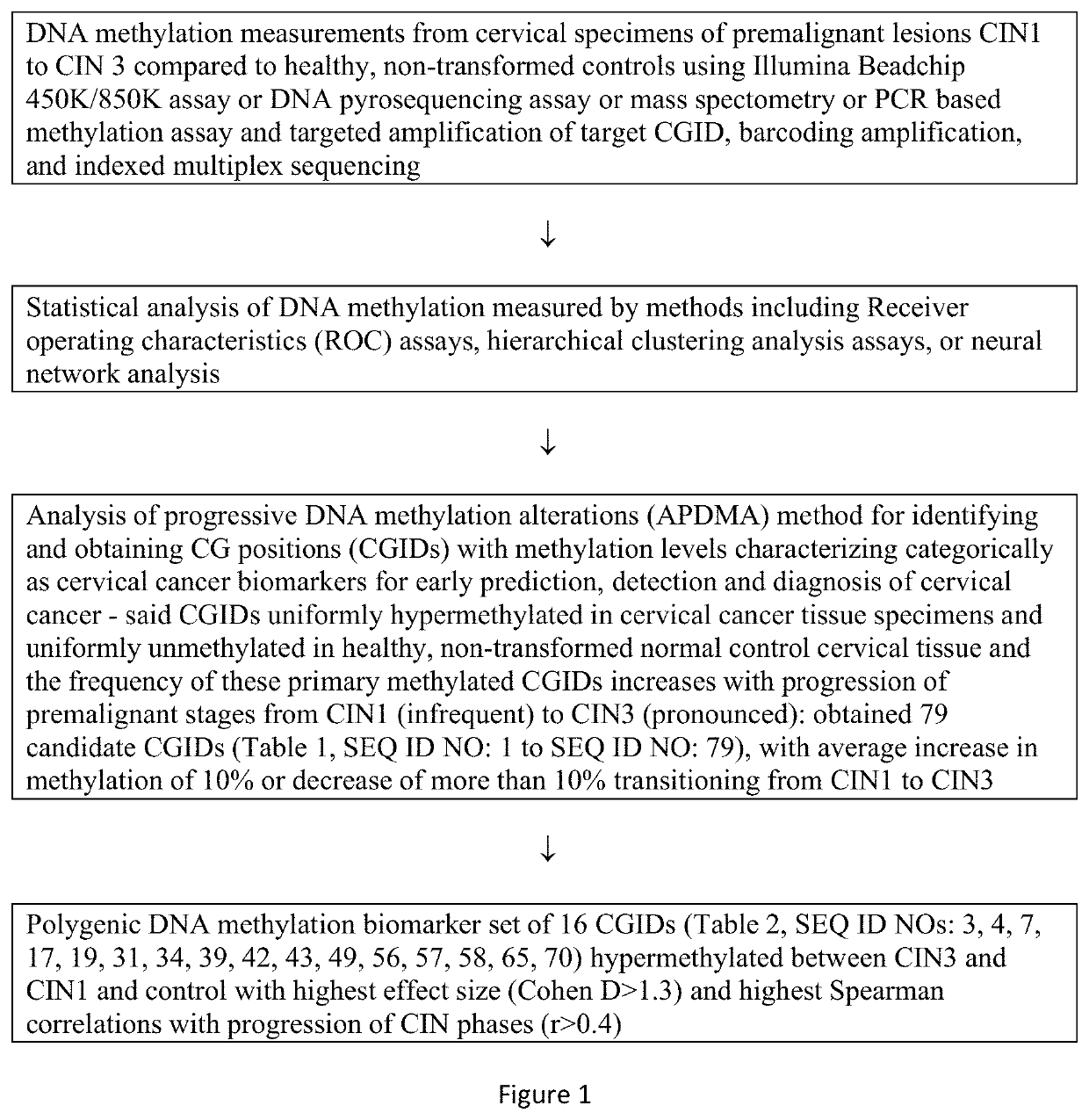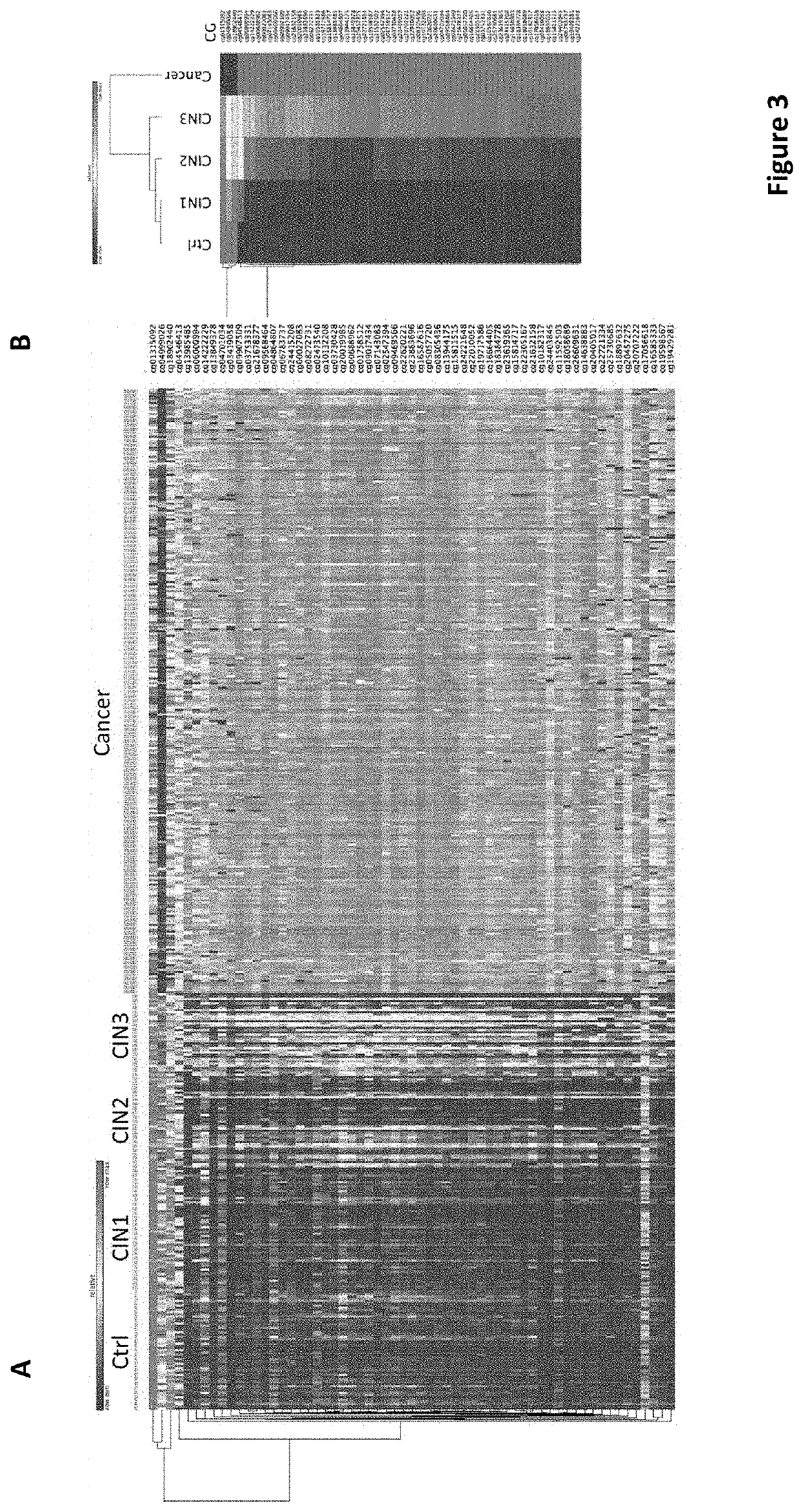DNA methylation biomarkers for early detection of cervical cancer
a methylation biomarker and cervical cancer technology, applied in the field ofmolecular diagnostics, can solve the problems of significant dilemma, lack of robust, highly accurate and sensitive methods for early detection of cervical cancer, increase the risk of miscarriage or premature delivery, etc., and achieve high throughput, accurate, robust, and high accuracy.
- Summary
- Abstract
- Description
- Claims
- Application Information
AI Technical Summary
Benefits of technology
Problems solved by technology
Method used
Image
Examples
example 1
of Progressive DNA Methylation Alterations (APDMA) Method for Identifying and Obtaining CG Positions (CGIDs) Whose Methylation Level is an Early Predictor of Cervical Cancer
[0089]The present invention addresses one of the outstanding challenges in cervical cancer screening which is finding robust biomarkers that provide a highly accurate and sensitive assessment of risk that can guide early intervention and treatment. Common approaches have been using a case-control logistic regression on genome wide DNA methylation data to identify sites that are either more of less methylated in cancer cells versus controls. However, it is well known that many statistically significant DNA methylation alterations in cancer detected by these methods are heterogenous and many evolve late in the progression of cancer and therefore of very limited value in early detection, since they are diluted when the frequency of cancer cells in a specimen is low. Moreover, quantitative differences in methylation ...
example 2
of a Polygenic DNA Methylation Biomarker Set for Early Detection of Cervical Cancer
[0099]The present disclosure further shortlists 16 CGIDs from the list obtained and disclosed in the first example and in Table 1, where the said 16 CGIDs were hypermethylated between CIN3 and CIN1 and control, had the highest effect size (Cohen D>1.3) between CIN3 and control and highest Spearman correlation with progression of CIN phases r>0.4. (refer to Table 2 herein above).
[0100]Next, in order to obtain the minimal number of CGIDs required for differentiating CIN3 premalignant lesions from control, the present method performed a penalized regression which reduced the number of CGIDs to 5. The present method then performed a multivariable linear regression with these 5 CGIDs as independent variables and CIN3 state as the dependent variable. Two CGIDs remained significant (refer to Table 3 herein above). A linear regression equation composed of weighted methylation levels of these two sites was hig...
example 3
f Bi-Genic DNA Methylation Markers for Detecting Cervical Cancer
[0101]Next, the present disclosure first validated the bigenic DNA methylation marker (cg03419058; cg13944175) on the publicly available data base of cervical cancer 450K DNA methylation (refer to GSE68339). A bivariable linear regression model with cervical cancer as the dependent variable and the level of methylation of the two CGIDs (cg03419058; cg13944175) as independent variables was observed to be highly significant (p−16′ F=8703, R=0.9873). ROCs for the methylation scores (calculated using the linear regression equation as disclosed in FIG. 4A) were compared by calculating their area under the curve (AUC) (refer to FIG. 413). The sensitivity and specificity of the bigenic methylation score for discriminating cervical cancer from normal cervical tissue was observed to be 1 (refer to FIG. 4C).
[0102]Thus, the above disclosed DNA methylation biomarkers and the calculated methylation score are useful for screening and...
PUM
| Property | Measurement | Unit |
|---|---|---|
| mass spectrometry | aaaaa | aaaaa |
| frequency | aaaaa | aaaaa |
| size | aaaaa | aaaaa |
Abstract
Description
Claims
Application Information
 Login to View More
Login to View More - R&D
- Intellectual Property
- Life Sciences
- Materials
- Tech Scout
- Unparalleled Data Quality
- Higher Quality Content
- 60% Fewer Hallucinations
Browse by: Latest US Patents, China's latest patents, Technical Efficacy Thesaurus, Application Domain, Technology Topic, Popular Technical Reports.
© 2025 PatSnap. All rights reserved.Legal|Privacy policy|Modern Slavery Act Transparency Statement|Sitemap|About US| Contact US: help@patsnap.com



